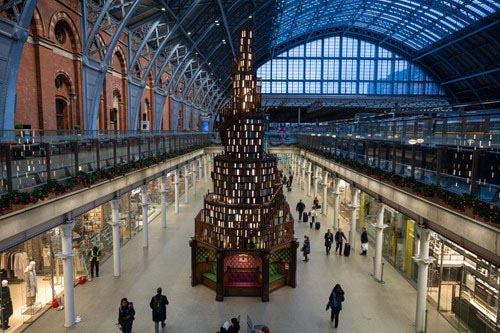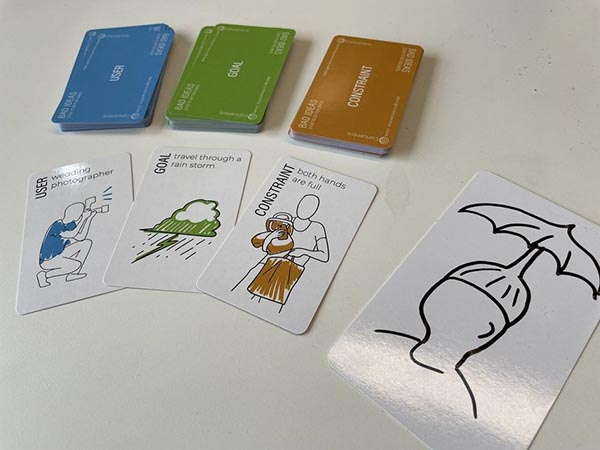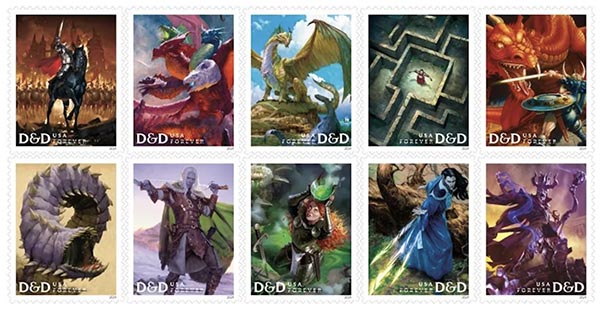
“Is This the Real Life? Is This Just Fantasy?”
The major dictionaries have announced their “words of the year,” and we know you have been crouched in a state of cat-like readiness awaiting this year’s lexical trends. Via The Guardian, Merriam-Webster, Cambridge, and Collins are generally on the same page—or so it would seem. First up: Merriam-Webster says that the word of the year is “authentic.” For real?
In its announcement, the dictionary said the word had seen a big jump in searches this year, thanks to discussions “about AI, celebrity culture, identity, and social media”. It makes a lot of sense – the concept of authenticity does, to use another buzzy phrase, sit at the intersection of so much of what’s been on our collective minds.
Cambridge, perhaps channeling 1968, selected “hallucinate.” Or are we imagining that? Anyway, the use of the word centered around “generative AI.”
“It’s far from perfect as it’s capable of producing false information – hallucinations – and presenting this information as fact.”
Timothy Leary’s dead? No, he’s outside, looking in…and perhaps using AI. (All this would be great if it would being back psychedelia.)
Collins minces no words (well, they are a dictionary): their choice is “AI.” A bit too on-the-nose, perhaps, although all these words of the year are based on user searches.
Merriam-Webster points out that “authenticity itself has become a performance. In other words, we’re getting very good at pretending to be real.” Or, as Groucho Marx once said, “The secret of life is honesty and fair dealing. If you can fake that, you’ve got it made.”
But what’s really real is, unfortunately, often not that interesting.
Says who? The images from the James Webb Space Telescope are pretty awesome, to name just one example of a real thing that’s interesting.
The BeReal app, which attempts to showcase users’ authentic selves by forcing them to take and post pictures when they least expect to – even if what they’re doing at that moment is deeply unflattering – seems to have been a flash in the pan.
Yeah, well, not among a couple of teenagers we know. (The M.O. behind BeReal, as we understand it—and we don’t—is that people bemoaned that people on Facebook, et al., only ever post positive news about themselves. Well, duh, of course! You don’t put the test you failed on the refrigerator.)
Maybe it’s time to take a different view of authenticity. What if we accept our social media feeds as not who we are but carefully curated extensions of ourselves – like little aspirational art projects? After all, who we want to be is an important part of our identity. Instead of seeing Instagram and TikTok as performed authenticity, maybe we can see them for what they are: authentic performances.
Or, maybe it’s time to give up social media entirely and interact with real people in real places.
Eat the Peach
It’s not just the “word of the year” that is anticipated around this time, but also Pantone’s Color of the Year. Just announced, the color for 2024 is…Peach Fuzz. OK, then. Via Print magazine:
“A cozy peach hue softly nestled between pink and orange, PANTONE 13-1023 Peach Fuzz brings belonging, inspires recalibration, and an opportunity for nurturing, conjuring up an air of calm, offering us a space to be, feel, and heal and to flourish from whether spending time with others or taking the time to enjoy a moment by ourselves.” —Leatrice Eiseman, Executive Director, Pantone Color Institute

Peachy.
The Front Page
Our Mount Monadnock Media Maven points us to an interesting hit of newspaper history: World War II troop newspapers. From the New Hampshire Union Leader:
The story of the American military’s troop newspapers in World War II has faded like old newsprint in the eight decades since. But at their peak as many as 4,600 individual newspapers were in circulation worldwide. Army Chief of Staff George Marshall spearheaded the newspaper initiative as a way to boost morale for troops. As well, the papers helped troops in Europe and the Pacific understand what they were doing, why they were fighting, and much more, (author) Manning says.
…Marshall saw troop newspapers as a way to boost morale by giving American forces the ability to tell their own stories as they fought in combat, worked behind front lines or at bases in the United States. So the Army created, and other branches adopted, a kind of newspaper-in-a-box kit: One big crate that included all the supplies necessary to publish — typewriters, cameras, mimeograph machines, ink and paper.
The newspapers included stories about the war, obituary notices for fallen comrades, cartoons, poems written by soldiers, sailors and Marines, and letters to the editor to praise or complain about matters within the individual unit. (G.I. gripes were always popular: The Bitching Post was the title of one troop newspaper’s popular complaints column.)
Sounds kind of like publishing a show daily. Anyway, the story of WWII troop newspapers is told in a new book, War of Words: How America’s GI Journalists Battled Censorship and Propaganda to Help Win World War II by Molly Guptill Manning. More info here.
The Past Is Present
When in New York City, why not check out the intersection of Broadway and West 157th Street, where a very cool lenticular image alternates between the street scene as it exists today and the way it looked in 1910.
Transitioning from an archival image which depicts the site in 1910, into a contemporary photograph of the same location taken by Adrian Sas in 2023, Broadway: Now & Again publicly presents an unexpected and dynamic visual interplay that encourages contemplation of how time shapes our surroundings.
Sas partnered with the New York City Department of Parks and Recreation to develop and install the dynamic image.
Big Apple Design
NYCxDesign is an organization that champions the New York City design community with a variety of programs and other initiatives. Via Core77, a recent NYCxDesign project is a poster collection from local designers that aims to “capture the essence of creativity in the city that never sleeps.”

Standard Issue, The Pulse of the City
The latest posters—as well as a previous series—are available for purchase.
Readin’ Around the Christmas Tree
If you happen to be in London this holiday season, be sure to pop into St. Pancreas Pancras train station and check out their unique Christmas tree. Created in collaboration with bookseller Hatchards, the 12-meter tall display is “a literary wonderland inspired by the enchanting realms created by authors.”
The tree features a whimsical design with a winding staircase and 270 shelves adorned with over 3,800 hand-painted books, including timeless classics like Charles Dickens’ “A Christmas Carol” and C.S. Lewis’ “The Lion, The Witch, and the Wardrobe.”
Within this majestic tree are eight cosy nooks where visitors, young and old, can immerse themselves in the magic of Christmas, figuratively and literally. Each booth is equipped with speakers that allow you to select a five-minute excerpt from an audiobook, exclusively provided by Penguin Books. You can choose from a selection of sixteen different audios, featuring authors like Charles Dickens, Beatrix Potter, Zadie Smith, and more. It's the perfect free attraction for families or a relaxing stop on your journey through St. Pancras.
Even better:
This extraordinary festive display not only celebrates literature but also encourages a break from screens and a deeper connection with the joy of reading. In a world where BookTok and social media trends have sparked a 25% increase in young people's reading habits, St. Pancras and Hatchards hope to inspire a return to the transformative power of books.

Pretty cool.
A Wicked Pack of Cards
Do you have bad ideas? (Any regular reader of Around the Web knows that we have no shortage of them around here.) But how do you take a bad idea and turn it into a better one? We’re certainly keen to find out—via Core 77, designer Jake Rynkiewicz has invented a card game called “Bad Ideas (Lead to Better Ones),” which uses creativity to help individuals or teams come up with good (or better) ideas.
The game consists of 75 cards with 3 categories: users, goals, and constraints. When the cards are combined together, they create a randomized problem to solve. Then it's up to you and the other players to think of the most inventive solution.

The primary goal of Bad Ideas is to foster creativity by making it easy to integrate into other projects. Each round of Bad Ideas only takes a few minutes, so it can be plugged into the beginning of a project focused on sketching or 3d modeling or storytelling. Then you have something to react to and modify rather than starting from a completely blank page.
The secondary goal of the game is to spread the idea that creativity is a more approachable concept than many would like to think. After refining the gameplay of Bad Ideas, I realized this could be something more universal than a tool specifically for design students. The game is designed to be played by just about anyone!
The deck is available via Kickstarter for $25 or $5 for a print-them-yourself PDF deck. Good idea?
+4 Postal Carrier
Are you now—or have you ever been—an avid Dungeons & Dragons player? Do you still have 20-sided dice in a drawer somewhere? And do you mail things? If so, good news! To commemorate the 50th anniversary of the classic role-playing game, the United States Postal Service (USPS) is releasing a series of D&D “Forever” stamps, designed by artist Greg Breeding. Says Laughing Squid:
This stamp release marks the 50th anniversary of Dungeons & Dragons, described by its owners as the World’s Greatest Role-playing Game, which has become a cultural phenomenon. …The pane of 20 stamps features 10 different designs that highlight characters, creatures, and encounters familiar to players of the game. Greg Breeding, an art director for USPS, designed the stamps and pane with existing illustrations.

Perfect for recalling those hours of your youth spent in a friend’s basement til all hours doing battle with all sorts of imaginary creatures.
Graphene Gets in Your Head
Was it a good week for graphene news? It’s always a good week for graphene news! Graphene-based headphone drivers. From (who else?) Graphene-Info:
Ora Graphene, producer of free-standing graphene membranes, announced a partnership with Taiwan-based Merry Electronics to develop off-the-shelf GrapheneQ headphone drivers. These, according to Ora, will be the world's first commercially available graphene-based drivers. The two companies will offer 40 mm and 50 mm drivers, which will be available for pre-order in Q1 2024.
And the advantage of graphene-based headphone drivers?
According to Ora, the graphene-based drivers will radically enhance audio reproduction, eliminating distortion and pushing speaker breakup three to four times higher than current solutions. Ora’s breakthrough technology promises to deliver an unparalleled audio experience for consumers.
Dark Side of the Moon would be the real test…
It’s a Gas
Are you traveling this holiday season? By car? If so, Atlas Obscura helpfully identifies “America’s grandest gas stations”—if you’re going to gas up (if you don’t have an EV), might as well do it in style. So what makes a gas station “grand”?
When travelers pull into this tiny gas station in Cloquet, Minnesota with a lookout tower, they are stopping at a piece created by an architectural legend. The Frank Lloyd Wright Gas Station was originally designed as a home for a Cloquet resident, who happened to be in the petroleum business. Across the country in the deserts of Hanksville, Utah, a stop at the Hallow Mountain gas stations means walking into a rockface. The convenience store that services the stations was built directly into the rocky Utah terrain, offering an escape from the heat.

OK, that’s pretty cool.
Other destinations include the last “Shell Oil Clamshell” station in Winston-Salem, N.C.; the Warren Harding Administration-inspired “Teapot Dome Service Station” in Zillah, Wash.; and the “Watergate Gas Station”near the titular hotel in Washington, D.C. And if you are a fan of former president Rutherford B. Hayes (for reasons passing understanding), you can visit the gas station that was built on the site of where his home was torn down in Delaware, Ohio.

We’d be pumped to visit any of these stations….
Kiss (Not) Alive
Says Gizmodo: “Thanks to Industrial Light and Magic, Gene Simmons’ hologram tongue will wag at audiences until the end of time.” Sure, threaten us, why don’t you?
So, why would such a thing happen?
For those who wisely do not follow these things, veteran rock band KISS has just finished what they are calling their final tour—but they will still be on tour presumably forever…as digital avatars.
KISS left the stage during an encore at New York’s Madison Square Garden Saturday, but the show wasn’t over. According to the Associated Press, in place of the musicians, 8-foot-tall holograms of the band members flew out, floating above the audience and breathing fire as they treated the crowd to a robotic rendition of “God Gave Rock ‘n’ Roll To You II,” a musical crime from the 1991 album Revenge.
Sounds even more horrifying than the band itself.
The digital avatars were created in partnership with George Lucas’s special effects company Industrial Light & Magic (ILM) and Pophouse Entertainment Group, which was co-founded by Abba’s Björn Ulvaeus. The tech had its dad-rock-debut in 2021 for the “Abba Voyage” show in London, where a digitally hallucinated 3D version of the Swedish band plays a pre-recorded concert.
“Digitally hallucinated.” Is this what we’re calling it now? (The Cambridge dictionary was apparently right…)
KISS is a particularly cynical music business enterprise. Among the band’s more ridiculous products, the band will charge you $3.99 for an empty bag of “air guitar strings.” There’s a limited edition KISS x Hello Kitty toilet paper, now out of production but available on eBay for as little as $34.99. You can even get buried in a $5,000 KISS coffin. It’s only natural that the band should find a way to profit off of live shows after time renders their physical forms too decrepit to wield a guitar.
“Two Nations Divided By a Common Language”
It’s a phrase variously attributed to Oscar Wilde, George Bernard Shaw, and sometimes even Winston Churchill, but the difference between American and British English is perhaps nowhere more exemplified than in the terms for potato products. For example, what we Yanks call “french fries” are called, in the UK (and elsewhere in Europe) chips. And what we call “potato chips” are called in the UK “crisps.” (Interestingly, if you order “fish and chips” in an American restaurant, you will unfailingly get British chips…that is, fries. On exactly one occasion in the last 30+ years has a waitperson pointed out what specifically one would be getting, so perhaps if you’re likely to be ordering fish and chips, you’re likely to know what to expect.
So, the question remains: why did this potato disparity rise in the first place? British vlogger Patrick Foote of Name Explain takes a stab at tracing the respective etymologies. It all started in Belgium, where frites—meaning fried—came about. This is the origin of the “french fries.” (They were Belgian not French.)
Apparently, during the First World War, American soldiers stationed in Belgium came across these potatoes cooked in a way that they had never seen before. They liked them so much that they brought them back to the USA with them and adapted the name of frites into fries. They specifically called them French fries because the part of Belgium they came from spoke French.
As for potato chips (aka crisps), they were (arguably) invented near Saratoga Springs, N.Y., when a restaurant customer complained that his fries were “too thick.” So the chef sliced the potato very thin—and the “Saratoga chip” was invented. The chef in question used the term “chips” because “they were little chippings of a potato.” And by the time these chips made it across the pond, the term was already in use.
These chips were so popular that they made their way to the UK eventually too yet there was a bit of an issue they couldn’t really be called chips because by this point chips were already being used as the name for a different kind of potato. The fish and chips kind of chips. A new name had to be devised eventually the name crisps was landed on.
It’s all rather confusing, really. Check out the whole discussion.
This Week in Printing, Publishing, and Media History
December 4
1732: English poet and playwright John Gay dies (b. 1685).
1791: The first edition of The Observer, the world’s first Sunday newspaper, is published in the U.K.
1875: Austrian-Swiss poet and author Rainer Maria Rilke born.
1881: The first edition of the Los Angeles Times is published.
1965: The Grateful Dead makes its first concert performance under that name (they had been founded as The Warlocks).
1993: American singer-songwriter, guitarist, and producer Frank Zappa dies (b. 1940).
December 5
1791: Austrian composer and musician Wolfgang Amadeus Mozart dies (b. 1756).
1901: American animator, director, producer, and screenwriter Walt Disney born.
1901: German physicist and Nobel Prize laureate Werner Heisenberg born. Of that there is no uncertainty.
December 6
1877: The first edition of The Washington Post is published.
1953: Vladimir Nabokov completes his controversial novel Lolita.
1955: American actor, comedian, and screenwriter Steven Wright born.
December 7
43 BC: Roman philosopher, lawyer, and politician Cicero dies (b. 106 BC).
1902: German-American cartoonist Thomas Nast dies (b. 1840).
1923: American actor and comedian Ted Knight born.
1930: W1XAV in Boston, Massachusetts telecasts video from the CBS radio orchestra program, The Fox Trappers. The telecast also includes the first television commercial in the United States, an advertisement for I.J. Fox Furriers, who sponsored the radio show.
December 8
65 BC: Roman soldier and poet Horace born.
1861: American businessman, and founder of General Motors and Chevrolet, William C. Durant born.
1894: American humorist and cartoonist James Thurber born.
1951: American essayist, travel and science writer Bill Bryson born.
1962: Workers at four New York City newspapers (this later increases to nine) go on strike for 114 days.
1980: John Lennon is murdered by Mark David Chapman in front of The Dakota in New York City.
2013: Metallica performs a show in Antarctica, making them the first band to perform on all seven continents. (Master of Penguins?)
2019: First confirmed case of COVID-19 in China.
December 9
1608: English poet and philosopher John Milton born. (“There goes paradise,” said his mother.)
1793: New York City’s first daily newspaper, the American Minerva, is established by Noah Webster.
1897: Activist Marguerite Durand founds the feminist daily newspaper La Fronde in Paris.
1906: American admiral, computer scientist, and designer of COBOL Grace Hopper born.
1960: The first episode of Coronation Street, the world’s longest-running television soap opera, is broadcast in the United Kingdom.
1965: A Charlie Brown Christmas, first in a series of Peanuts television specials, debuts on CBS.
1968: Douglas Engelbart gives what became known as “The Mother of All Demos,” publicly debuting the computer mouse, hypertext, and the bit-mapped graphical user interface using the oN-Line System (NLS) at the Association for Computing Machinery/Institute of Electrical and Electronics Engineers (ACM/IEEE)—Computer Society's Fall Joint Computer Conference in San Francisco.
1979: The eradication of the smallpox virus is certified, making smallpox the first of only two diseases that have been driven to extinction (rinderpest in 2011 being the other).
December 10
1520: Martin Luther burns his copy of the papal bull Exsurge Domine outside Wittenberg's Elster Gate.
1768: The first edition of the Encyclopædia Britannica is published.
1815: English mathematician and computer scientist Ada Lovelace born. Working on Charles Babbage’s Analytical Engine, she s often considered the first computer programmer. (She was also the only legitimate daughter of Lord Byron.)
1830: American poet and author Emily Dickinson born.
1851: American librarian and educator, creator of the Dewey Decimal Classification Melvil Dewey born.
1884: Mark Twain’s Adventures of Huckleberry Finn is published.
1909: Selma Lagerlöf becomes the first female writer to win the Nobel Prize in Literature.
1936: Italian dramatist, novelist, and poet Nobel Prize laureate Luigi Pirandello dies (b. 1867).
1946: American newspaperman and short story writer Damon Runyon dies (b. 1884).















Discussion
Only verified members can comment.